
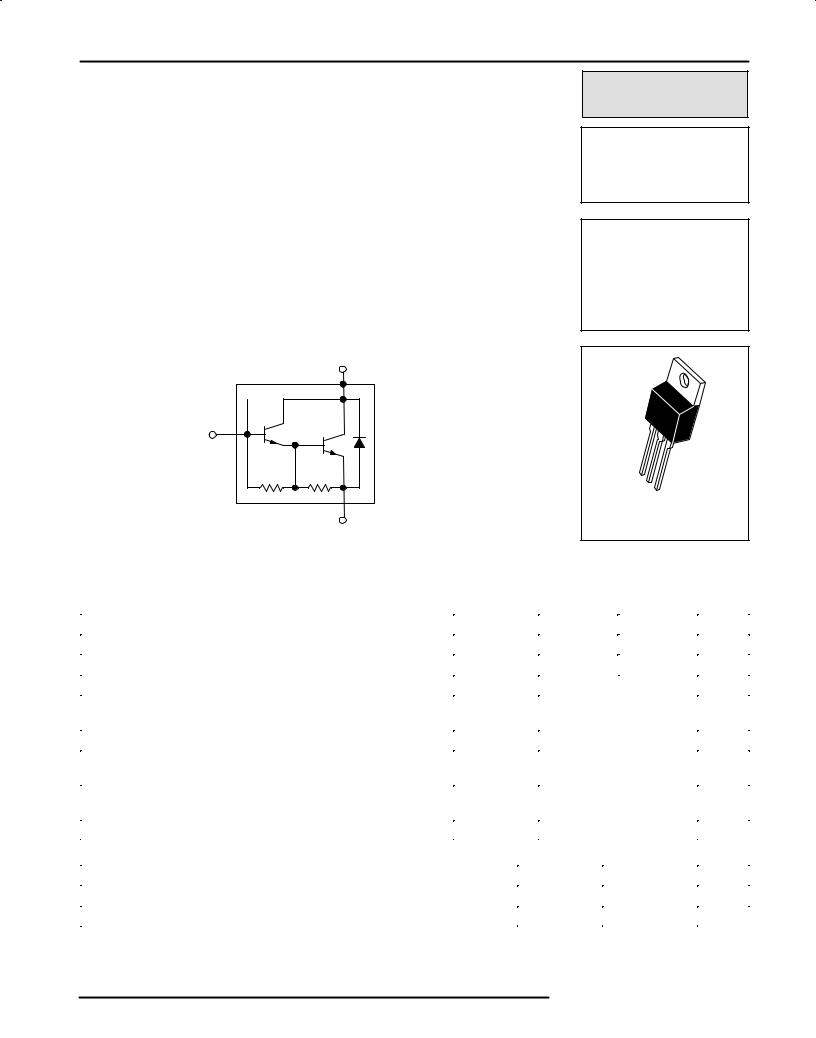
MOTOROLA
SEMICONDUCTOR TECHNICAL DATA
Order this document by 2N6667/D
2N6609 (See 2N3773)
Darlington Silicon
Power Transistors
. . . designed for general±purpose amplifier and low speed switching applications.
•High DC Current Gain Ð h FE = 3500 (Typ) @ IC = 4 Adc
•Collector±Emitter Sustaining Voltage Ð @ 200 mAdc
VCEO(sus) = 60 Vdc (Min) Ð 2N6667
VCEO(sus) = 80 Vdc (Min) Ð 2N6668
•Low Collector±Emitter Saturation Voltage Ð V CE(sat) = 2 Vdc (Max) @ IC = 5 Adc
•Monolithic Construction with Built±In Base±Emitter Shunt Resistors
•TO±220AB Compact Package
•Complementary to 2N6387, 2N6388
2N6667
2N6668
PNP SILICON
DARLINGTON
POWER TRANSISTORS
10 AMPERES
60 ± 80 VOLTS
65 WATTS
|
COLLECTOR |
BASE |
|
[ 8 k |
[ 120 |
CASE 221A±06
TO±220AB
EMITTER
Figure 1. Darlington Schematic
MAXIMUM RATINGS (1)
Rating |
Symbol |
2N6667 |
|
2N6668 |
Unit |
|
|
|
|
|
|
Collector±Emitter Voltage |
VCEO |
60 |
|
80 |
Vdc |
Collector±Base Voltage |
VCB |
60 |
|
80 |
Vdc |
Emitter±Base Voltage |
VEB |
|
5 |
Vdc |
|
Collector Current Ð Continuous |
IC |
|
10 |
Adc |
|
Ð Peak |
|
|
15 |
|
|
|
|
|
|
|
|
Base Current |
IB |
|
250 |
mAdc |
|
Total Device Dissipation @ TC = 25_C |
PD |
|
65 |
watts |
|
Derate above 25_C |
|
|
0.52 |
W/_C |
|
|
|
|
|
|
|
Total Device Dissipation @ TA = 25_C |
PD |
|
2 |
Watts |
|
Derate above 25_C |
|
|
0.016 |
W/_C |
|
|
|
|
|
||
Operating and Storage Junction Temperature Range |
TJ, Tstg |
± 65 to +150 |
_C |
||
THERMAL CHARACTERISTICS
Characteristic |
Symbol |
Max |
Unit |
|
|
|
|
Thermal Resistance, Junction to Case |
RθJC |
1.92 |
_C/W |
Thermal Resistance, Junction to Ambient |
RθJA |
62.5 |
_C/W |
(1) Indicates JEDEC Registered Data.
REV 1
Motorola, Inc. 1995
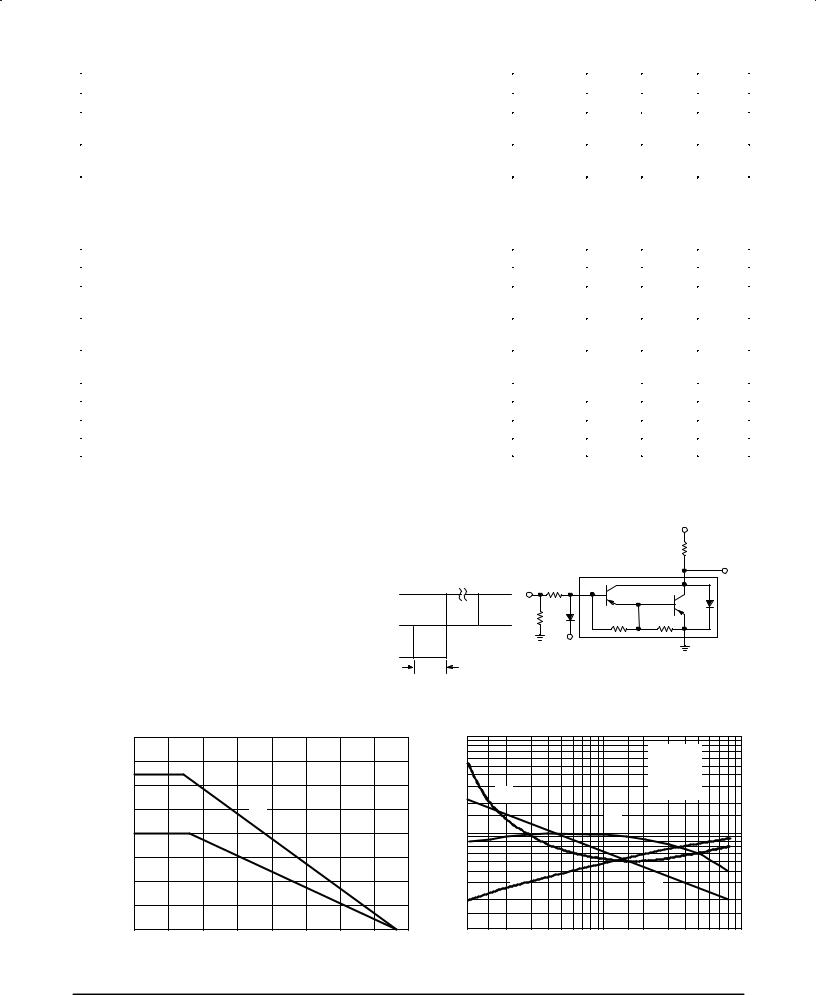
2N6667 |
2N6668 |
|
|
|
|
|
|
|
*ELECTRICAL CHARACTERISTICS (TC = 25_C unless otherwise noted) |
|
|
|
|
|
|
|
|
|
|
|
|
|
|
|
|
Characteristic |
|
Symbol |
Min |
Max |
Unit |
|
|
|
|
|
|
|
|
|
OFF CHARACTERISTICS |
|
|
|
|
|
|
|
|
|
|
|
|
|
|
|
Collector±Emitter Sustaining Voltage (1) |
2N6667 |
VCEO(sus) |
60 |
Ð |
Vdc |
|
|
(IC = 200 mAdc, IB = 0) |
2N6668 |
|
80 |
Ð |
|
|
|
Collector Cutoff Current (VCE = 60 Vdc, IB = 0) |
2N6667 |
ICEO |
Ð |
1 |
mAdc |
|
|
|
(VCE = 80 Vdc, IB = 0) |
2N6668 |
|
Ð |
1 |
|
|
Collector Cutoff Current |
|
|
|
|
|
|
|
(VCE = 60 Vdc, VEB(off) = 1.5 Vdc) |
2N6667 |
ICEX |
Ð |
300 |
μAdc |
|
|
(VCE = 80 Vdc, VEB(off) = 1.5 Vdc) |
2N6668 |
|
Ð |
300 |
|
|
|
(VCE = 60 Vdc, VEB(off) = 1.5 Vdc, TC = 125_C) |
2N6667 |
|
Ð |
3 |
mAdc |
|
|
(VCE = 80 Vdc, VEB(off) = 1.5 Vdc, TC = 125_C) |
2N6668 |
|
Ð |
3 |
|
|
|
Emitter Cutoff Current (VBE = 5 Vdc, IC = 0) |
|
IEBO |
Ð |
5 |
mAdc |
|
|
ON CHARACTERISTICS (1) |
|
|
|
|
|
|
|
|
|
|
|
|
|
|
|
DC Current Gain (IC = 5 Adc, VCE = 3 Vdc) |
|
hFE |
1000 |
20000 |
Ð |
|
|
|
(IC = 10 Adc, VCE = 3 Vdc) |
|
|
100 |
Ð |
|
|
Collector±Emitter Saturation Voltage (IC = 5 Adc, IB = 0.01 Adc) |
|
VCE(sat) |
Ð |
2 |
Vdc |
|
|
|
(IC = 10 Adc, IB = 0.1 Adc) |
|
|
Ð |
3 |
|
|
Base±Emitter Saturation Voltage(IC = 5 Adc, IB = 0.01 Adc) |
|
VBE(sat) |
Ð |
2.8 |
Vdc |
|
|
|
(IC = 10 Adc, IB = 0.1 Adc) |
|
|
Ð |
4.5 |
|
|
DYNAMIC CHARACTERISTICS |
|
|
|
|
|
|
|
|
|
|
|
|
|
|
|
Current Gain Ð Bandwidth Product (I C = 1 Adc, VCE = 5 Vdc, ftest = 1 MHz) |
|
|hfe| |
20 |
Ð |
Ð |
|
|
Output Capacitance (VCB = 10 Vdc, IE = 0, f = 1 MHz) |
|
Cob |
Ð |
200 |
pF |
|
|
Small±Signal Current Gain (IC = 1 Adc, VCE = 5 Vdc, f = 1 kHz) |
|
hfe |
1000 |
Ð |
Ð |
|
|
* Indicates JEDEC Registered Data |
|
|
|
|
|
|
|
(1) Pulse Test: Pulse Width v 300 μs, Duty Cycle v 2%. |
|
|
|
|
|
|
VCC
± 30 V
RB & RC VARIED TO OBTAIN DESIRED CURRENT LEVELS D1, MUST BE FAST RECOVERY TYPES e.g.,
1N5825 USED ABOVE IB [ 100 mA MSD6100 USED BELOW IB [ 100 mA
FOR td AND tr, D1 IS DISCONNECTED AND V2 = 0
tr, tf v 10 ns
DUTY CYCLE = 1.0%
V2
APPROX
+ 8 V
0 |
|
V1 |
|
APPROX |
25 μs |
± 12 V |
RC SCOPE
|
|
|
TUT |
|
RB |
|
|
51 |
D1 |
[ 8 k |
[ 120 |
|
+ 4.0 V |
|
|
Figure 2. Switching Times Test Circuit
|
TA |
TC |
|
|
|
|
|
|
|
|
|
4 |
80 |
|
|
|
|
|
|
|
|
(WATTS) |
3 |
60 |
|
|
|
|
|
|
|
|
|
|
|
|
|
|
|
|
|
|
|
DISSIPATION |
|
|
|
|
|
TC |
|
|
|
|
2 |
40 |
|
|
|
|
|
|
|
|
|
|
|
|
|
|
|
|
|
|
|
|
POWER |
1 |
20 |
|
|
TA |
|
|
|
|
|
|
|
|
|
|
|
|
|
|||
, |
|
|
|
|
|
|
|
|
|
|
D |
|
|
|
|
|
|
|
|
|
|
P |
|
|
|
|
|
|
|
|
|
|
|
|
0 |
20 |
40 |
60 |
80 |
100 |
120 |
140 |
160 |
|
|
0 |
||||||||
|
|
|
|
|
T, TEMPERATURE (°C) |
|
|
|
||
Figure 3. Power Derating
|
10 |
|
|
|
|
|
|
|
|
|
|
|
7 |
|
|
|
|
|
|
VCC = 30 V |
|
|
|
|
5 |
|
|
|
|
|
|
IC/IB = 250 |
|
|
|
|
3 |
|
|
|
|
|
|
IB1 = IB2 |
|
|
|
|
t |
|
|
|
|
|
TJ = 25°C |
|
|
|
|
|
|
|
|
|
|
|
|
|
|
||
|
2 |
r |
|
|
|
|
|
|
|
|
|
μs) |
|
|
|
|
|
|
|
|
|
|
|
|
|
|
|
|
|
ts |
|
|
|
|
|
( |
|
|
|
|
|
|
|
|
|
|
|
TIME |
1 |
|
|
|
|
|
|
|
|
|
|
|
|
|
|
|
|
|
|
|
|
||
0.7 |
|
|
|
|
|
|
|
|
|
|
|
t, |
|
|
|
|
|
|
|
|
|
|
|
0.5 |
|
|
|
|
|
|
|
|
|
|
|
|
|
|
|
|
|
|
|
|
|
|
|
|
0.3 |
|
tf |
|
|
|
|
.td |
|
|
|
|
0.2 |
|
|
|
|
|
|
|
|
|
|
|
|
|
|
|
|
|
|
|
|
|
|
|
0.1 |
|
|
|
|
|
|
|
|
|
|
|
0.1 |
0.2 |
0.3 |
0.5 |
0.7 |
1 |
2 |
3 |
5 |
7 |
10 |
IC, COLLECTOR CURRENT (AMPS)
Figure 4. Typical Switching Times
3±2 |
Motorola Bipolar Power Transistor Device Data |
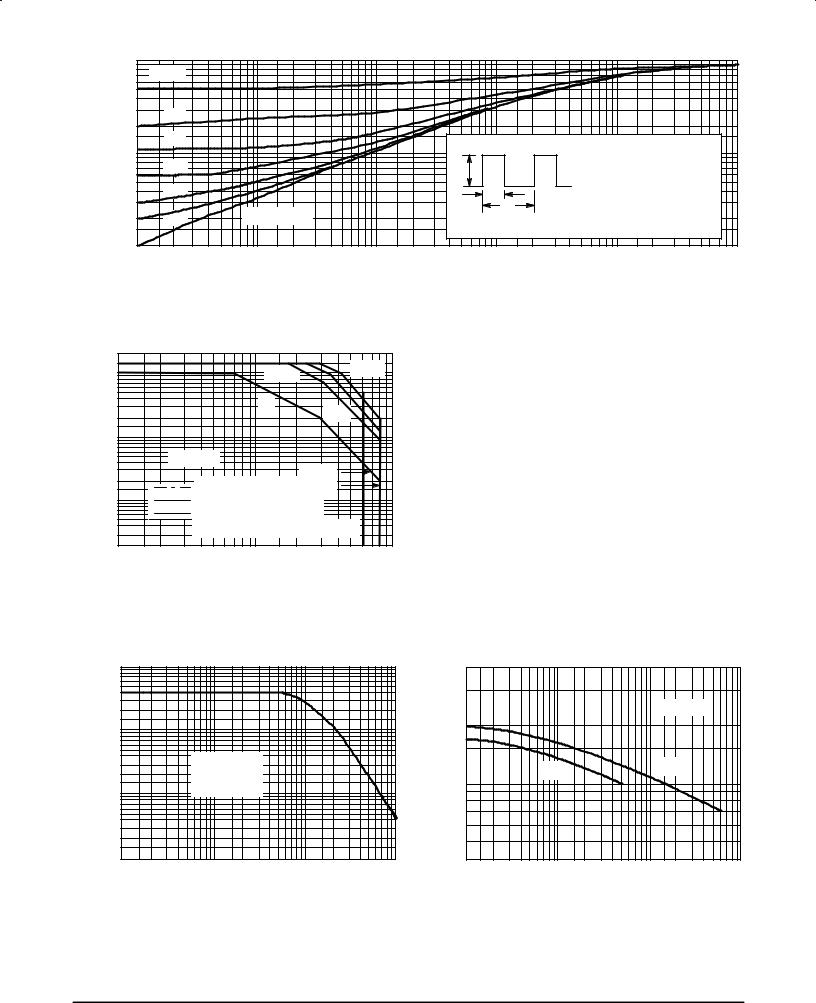
|
|
|
|
|
|
|
|
|
|
|
|
|
|
|
2N6667 |
2N6668 |
|
|
|
1 |
|
|
|
|
|
|
|
|
|
|
|
|
|
|
|
|
TRANSIENT THERMAL RESISTANCE |
|
D = 0.5 |
|
|
|
|
|
|
|
|
|
|
|
|
|
|
r(t) NORMALIZED EFFECTIVE |
0.5 |
|
|
|
|
|
|
|
|
|
|
|
|
|
|
|
|
0.3 |
0.2 |
|
|
|
|
|
|
|
|
|
|
|
|
|
|
||
0.2 |
|
|
|
|
|
|
|
|
|
|
|
|
|
|
|||
|
|
|
|
|
|
|
|
|
|
|
|
|
|
|
|||
0.1 |
0.1 |
|
|
|
|
|
|
P(pk) |
|
|
|
|
|
|
|||
|
|
|
|
|
|
|
|
|
ZθJC(t) = r(t) RθJC |
|
|
||||||
0.05 |
0.05 |
|
|
|
|
|
|
|
|
|
|
RθJC = 1.92°C/W MAX |
|
|
|||
|
|
|
|
|
|
|
|
|
|
|
D CURVES APPLY FOR POWER |
|
|||||
0.03 |
0.02 |
|
|
|
|
|
|
|
t1 |
|
|
|
|||||
|
|
|
|
|
|
|
t2 |
|
PULSE TRAIN SHOWN |
|
|
||||||
0.02 |
0.01 |
|
SINGLE PULSE |
|
|
|
|
|
|
READ TIME AT t1 |
|
|
|||||
|
|
|
|
|
|
|
|
TJ(pk) ± TC = P(pk) RθJC(t) |
|
||||||||
|
|
|
|
|
|
|
DUTY CYCLE, D = t1/t2 |
|
|
||||||||
|
|
0.01 |
|
|
|
|
|
|
|
|
|
|
|
|
|
||
|
|
0.02 |
0.05 |
0.1 |
0.2 |
0.5 |
1 |
2 |
5 |
10 |
20 |
50 |
100 |
200 |
500 |
1000 |
|
|
|
0.01 |
|||||||||||||||
t, TIME (ms)
Figure 5. Thermal Response
|
20 |
|
|
|
|
|
|
|
|
|
|
(AMPS) |
10 |
|
|
|
|
5 ms |
|
|
100 μs |
|
|
|
|
|
|
|
|
|
|
|
|||
5 |
|
|
|
|
dc |
|
|
|
|
|
|
3 |
|
|
|
|
|
|
|
|
|
||
CURRENT |
|
|
|
|
|
|
1 ms |
|
|
||
2 |
|
|
|
|
|
|
|
|
|||
|
|
|
|
|
|
|
|
|
|
||
1 |
|
|
|
|
|
|
|
|
|
|
|
0.5 |
|
TJ = 150°C |
|
|
|
|
|
|
|
||
COLLECTOR |
|
|
|
|
|
|
|
|
|||
0.3 |
|
|
|
|
|
2N6667 |
|
|
|
||
0.2 |
|
|
BONDING WIRE LIMIT |
2N6668 |
|
|
|
||||
0.1 |
|
|
|
|
|
||||||
|
|
THERMAL LIMIT @ TC = 25 |
° |
|
|
|
|||||
|
|
|
C |
|
|
|
|||||
, |
|
|
|
SECOND BREAKDOWN LIMIT |
|
|
|
||||
C |
0.05 |
|
|
|
|
|
|||||
I |
|
|
CURVES APPLY BELOW RATED VCEO |
|
|
||||||
|
|
|
|
|
|||||||
|
0.03 |
|
|
|
|
||||||
|
0.02 |
2 |
3 |
5 |
7 |
10 |
20 |
30 |
50 |
70 |
100 |
|
1 |
||||||||||
|
|
VCE, COLLECTOR±EMITTER VOLTAGE (VOLTS) |
|
|
|||||||
Figure 6. Maximum Safe Operating Area
10,000 |
|
|
|
|
|
|
|
|
|
|
|
GAIN |
5000 |
|
|
|
|
|
|
|
|
|
|
2000 |
|
|
|
|
|
|
|
|
|
|
|
CURENT |
|
|
|
|
|
|
|
|
|
|
|
1000 |
|
|
|
|
|
|
|
|
|
|
|
500 |
|
|
|
|
|
|
|
|
|
|
|
, SMALL±SIGNAL |
|
|
|
TC = 25°C |
|
|
|
|
|||
200 |
|
|
|
|
|
|
|
||||
|
|
|
VCE = 4 VOLTS |
|
|
|
|
||||
100 |
|
|
|
IC = 3 AMPS |
|
|
|
|
|||
50 |
|
|
|
|
|
|
|
|
|
|
|
FE |
|
|
|
|
|
|
|
|
|
|
|
h |
20 |
|
|
|
|
|
|
|
|
|
|
|
|
|
|
|
|
|
|
|
|
|
|
|
10 |
2 |
3 |
5 |
7 |
10 |
20 30 50 |
70 |
100 |
200 300 500 |
1000 |
|
1 |
||||||||||
f, FREQUENCY (kHz)
Figure 7. Typical Small±Signal Current Gain
There are two limitations on the power handling ability of a transistor: average junction temperature and second breakdown. Safe operating area curves indicate IC ± VCE limits of the transistor that must be observed for reliable operation; i.e., the transistor must not be subjected to greater dissipation than the curves indicate.
The data of Figure 6 is based on TJ(pk) = 150_C; TC is variable depending on conditions. Second breakdown pulse
limits are valid for duty cycles to 10% provided TJ(pk) < 150_C. TJ(pk) may be calculated from the data in Figure 5. At high case temperatures, thermal limitations will reduce the
power that can be handled to values less than the limitations imposed by second breakdown.
|
300 |
|
|
|
|
|
|
|
|
|
(pF) |
|
|
|
|
|
|
|
TJ = 25°C |
|
|
200 |
|
|
|
|
|
|
|
|
|
|
|
|
|
|
|
|
|
|
|
|
|
C, CAPACITANCE |
100 |
|
|
Cib |
|
|
|
Cob |
|
|
|
|
|
|
|
|
|
|
|
||
70 |
|
|
|
|
|
|
|
|
|
|
|
50 |
|
|
|
|
|
|
|
|
|
|
30 |
0.2 |
0.5 |
1 |
2 |
5 |
10 |
20 |
50 |
100 |
|
0.1 |
|||||||||
|
|
|
VR, REVERSE VOLTAGE (VOLTS) |
|
|
|||||
Figure 8. Typical Capacitance
Motorola Bipolar Power Transistor Device Data |
3±3 |
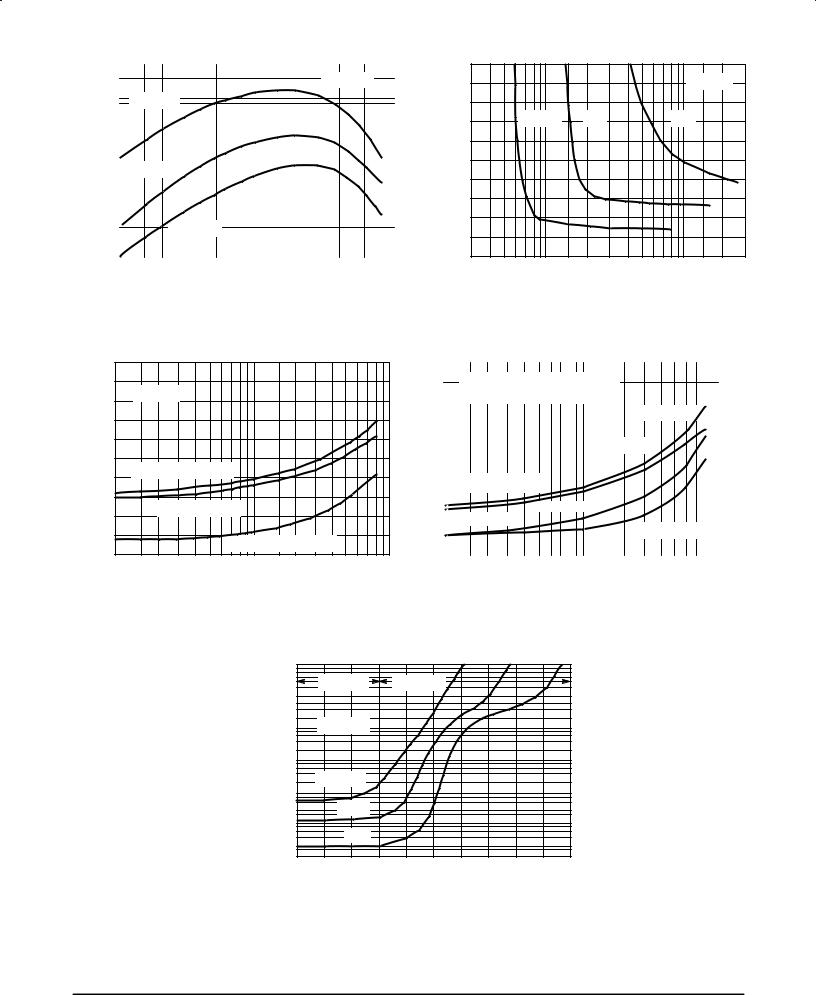
2N6667 |
|
2N6668 |
|
|
|
|
|
|
|
|
|
|
|
|
|
|
|
|
|
||||||
|
20,000 |
|
|
|
|
|
|
|
|
|
|
|
|
|
|
|
|
|
|
|
|
|
|
|
|
|
|
|
|
|
|
|
|
|
|
|
|
|
|
|
|
|
VCE = |
3 V |
|
|
|
|
|
||
|
10,000 |
|
|
|
|
|
|
|
|
|
|
|
|
|
|
|
|
|
|
|
|
|
|||
|
|
|
|
|
|
|
|
|
|
|
|
|
|
|
|
|
|
|
|
|
|
|
|
||
|
|
TJ |
= 150°C |
|
|
|
|
|
|
|
|
|
|
|
|
|
|
|
|
|
|
|
|||
GAIN |
|
7000 |
|
|
|
|
|
|
|
|
|
|
|
|
|
|
|
|
|
|
|
|
|||
|
|
|
|
|
|
|
|
|
|
|
|
|
|
|
|
|
|
|
|
|
|
|
|
||
|
5000 |
|
|
|
|
|
|
|
|
|
|
|
|
|
|
|
|
|
|
|
|
|
|
|
|
|
|
|
|
|
|
|
|
|
|
|
|
|
|
|
|
|
|
|
|
|
|
|
|
||
CURRENT |
|
3000 |
|
|
|
|
|
|
|
|
|
|
|
|
|
|
|
|
|
|
|
|
|
|
|
|
|
TJ = 25°C |
|
|
|
|
|
|
|
|
|
|
|
|
|
|
|
|
|
|
|
||||
|
|
|
|
|
|
|
|
|
|
|
|
|
|
|
|
|
|
|
|
|
|
|
|
|
|
, DC |
|
2000 |
|
|
|
|
|
|
|
|
|
|
|
|
|
|
|
|
|
|
|
|
|
|
|
|
|
|
|
|
|
|
|
|
|
|
|
|
|
|
|
|
|
|
|
|
|
|
|
||
|
1000 |
|
|
|
|
|
|
|
|
|
|
|
|
|
|
|
|
|
|
|
|
|
|
|
|
|
|
|
|
|
|
|
|
|
|
|
|
|
|
|
|
|
|
|
|
|
|
|
|
||
|
|
|
|
|
|
|
|
|
|
|
|
|
|
|
|
|
|
|
|
|
|
|
|
||
FE |
700 |
|
|
|
|
|
|
|
|
|
|
|
|
|
|
|
|
|
|
|
|
|
|
|
|
|
|
|
|
|
|
|
|
|
|
|
|
|
|
|
|
|
|
|
|
|
|
|
|||
h |
|
|
|
|
|
|
|
|
|
|
|
|
|
|
|
|
|
|
|
|
|
|
|
|
|
|
|
500 |
|
|
|
|
|
|
|
|
|
|
|
|
|
|
|
|
|
|
|
|
|
|
|
|
|
|
|
|
TJ |
= ± |
55° |
C |
|
|
|
|
|
|
|
|
|
|
|
|
|
|
|
||
|
|
300 |
|
|
|
|
|
|
|
|
|
|
|
|
|
|
|
|
|
|
|||||
|
|
|
|
|
|
|
|
|
|
|
|
|
|
|
|
|
|
|
|
|
|
|
|
|
|
|
|
200 |
|
|
|
|
|
|
|
|
|
|
|
|
|
|
|
|
|
|
|
|
|
|
|
|
|
0.1 |
0.2 |
0.3 |
0.5 |
0.7 |
1 |
2 |
3 |
5 |
7 |
10 |
|||||||||||||
IC, COLLECTOR CURRENT (AMPS)
Figure 9. Typical DC Current Gain
VCE, COLLECTOR±EMITTER VOLTAGE (VOLTS)
2.6
TJ = 25°C
2.2
IC = 2 A |
4 A |
6 A |
1.8
1.4
1 |
|
|
|
|
|
|
|
|
|
|
0.6 |
|
0.7 |
|
|
|
|
|
10 |
20 |
|
0.3 |
0.5 |
1 |
2 |
3 |
5 |
7 |
30 |
IB, BASE CURRENT (mA)
Figure 10. Typical Collector Saturation Region
V, VOLTAGE (VOLTS)
3
2.5TJ = 25°C
2
1.5VBE(sat) @ IC/IB = 250
1 VBE @ VCE = 3 V
VCE(sat) @ IC/IB = 250
0.5
0.1 |
0.2 |
0.3 |
0.5 |
0.7 |
1 |
2 |
3 |
5 |
7 |
10 |
|
|
IC, COLLECTOR CURRENT (AMPS) |
|
|
|
|||||
Figure 11. Typical ªOnº Voltages
θV, TEMPERATURE COEFFICIENTS (mV/°C)
+ 5 |
|
|
|
|
|
|
|
|
|
|
|
|
|
|
|
|
|
|
|
|
|
|
|
|
|
|
|
h |
|
|
|
|
|
|
|
|
|
|
|
|
|
|
|
|
|
||
+ 4 |
|
*I |
C/IB |
≤ |
FE @ V |
CE |
+ |
3.0 |
V |
|
|
|
|
|
|
|
|
|
|||||
+ 3 |
|
|
|
|
|
|
3 |
|
|
|
|
|
|
|
|
|
|
|
|
|
|||
|
|
|
|
|
|
|
|
|
|
|
|
|
|
|
25 |
°C |
to 150°C |
|
|
|
|
||
+ 2 |
|
|
|
|
|
|
|
|
|
|
|
|
|
|
|
|
|
|
|
||||
|
|
|
|
|
|
|
|
|
|
|
|
|
|
|
|
|
|
|
|
|
|
|
|
+ 1 |
|
|
|
|
|
|
|
|
|
|
|
|
|
|
|
|
|
|
|
|
|
|
|
|
|
|
|
|
|
|
|
|
|
|
|
± 55 |
°C to 25°C |
|
|
|
|
|
|
||||
|
|
|
|
|
|
|
|
|
|
|
|
|
|
|
|
|
|
|
|||||
0 |
|
|
|
|
|
|
|
|
|
|
|
|
|
|
|
|
|
|
|
|
|
|
|
|
|
|
|
|
|
|
|
|
|
|
|
|
|
|
|
|
|
|
|
|
|
|
|
± 1 |
|
|
|
|
|
|
|
|
|
|
|
|
|
|
|
|
|
|
|
|
|
|
|
|
|
θVC for |
VCE(sat) |
|
|
|
|
|
|
|
|
|
|
|
|
|
|
|
|||||
± 2 |
|
|
|
|
|
|
|
|
|
|
|
|
|
|
|
|
|
||||||
|
|
|
|
|
|
|
25°C to |
150°C |
|
|
|
|
|
|
|
|
|
||||||
± 3 |
|
|
|
|
|
|
|
|
|
|
|
|
|
|
|
|
|||||||
|
|
|
|
|
|
|
|
|
|
|
|
|
|
|
|
|
|
|
|
|
|
|
|
|
θVB for VBE |
|
|
|
|
|
|
|
|
|
± 55° |
C to 25°C |
|
|
|
||||||||
± 4 |
|
|
|
|
|
|
|
|
|
|
|
|
|
||||||||||
|
|
|
|
|
|
|
|
|
|
|
|
|
|
|
|
|
|
|
|
|
|
|
|
± 5 |
|
|
|
|
|
|
|
|
|
|
|
|
|
|
|
|
|
|
|
|
|
|
|
0.1 |
0.2 |
0.3 |
0.5 |
0.7 |
1 |
|
2 |
3 |
5 |
7 |
|
10 |
|||||||||||
IC, COLLECTOR CURRENT (AMP)
Figure 12. Typical Temperature Coefficients
|
105 |
|
|
|
|
|
|
|
|
|
|
104 |
REVERSE |
|
FORWARD |
|
|
|
|
||
|
|
|
|
|
|
|
|
|
|
|
μA) |
103 |
V |
= 30 V |
|
|
|
|
|
|
|
( |
|
|
|
|
|
|
|
|||
|
|
|
|
|
|
|
|
|||
CURRENT |
|
CE |
|
|
|
|
|
|
|
|
102 |
|
|
|
|
|
|
|
|
|
|
COLLECTOR |
101 |
TJ = 150°C |
|
|
|
|
|
|
|
|
|
|
|
|
|
|
|
|
|
||
100 |
|
100°C |
|
|
|
|
|
|
|
|
|
|
|
|
|
|
|
|
|
||
, |
|
|
|
|
|
|
|
|
|
|
C |
|
|
25°C |
|
|
|
|
|
|
|
I |
|
|
|
|
|
|
|
|
|
|
|
|
|
|
|
|
|
|
|
|
|
|
10± 1 |
|
|
|
|
|
|
|
|
|
|
+ 0.6 |
+ 0.4 |
+ 0.2 |
0 |
± 0.2 |
± 0.4 |
± 0.6 ± 0.8 |
± 1 |
± 1.2 |
± 1.4 |
|
|
|
VBE, BASE±EMITTER VOLTAGE (VOLTS) |
|
|
|||||
Figure 13. Typical Collector Cut±Off Region
3±4 |
Motorola Bipolar Power Transistor Device Data |
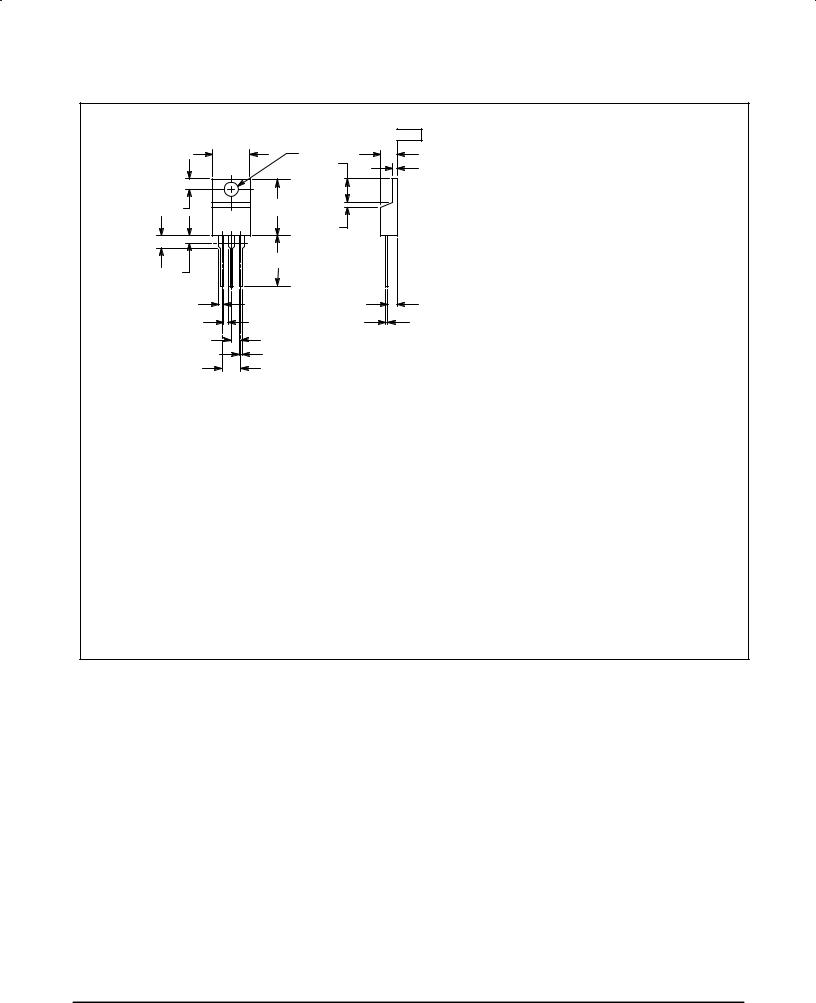
2N6667 2N6668
PACKAGE DIMENSIONS
|
|
|
|
±T± |
|
B |
|
F |
C |
|
|
|
T |
S |
4 |
|
|
|
|
Q |
|
|
A |
|
1 |
2 |
3 |
U |
|
H |
|
|
|
|
Z |
|
|
K |
|
|
|
|
|
|
L |
|
|
|
R |
V |
|
|
|
J |
G |
|
|
|
|
|
|
|
D |
|
|
N |
|
|
|
SEATING PLANE
NOTES:
1.DIMENSIONING AND TOLERANCING PER ANSI Y14.5M, 1982.
2.CONTROLLING DIMENSION: INCH.
3.DIMENSION Z DEFINES A ZONE WHERE ALL BODY AND LEAD IRREGULARITIES ARE ALLOWED.
|
INCHES |
MILLIMETERS |
||
DIM |
MIN |
MAX |
MIN |
MAX |
A |
0.570 |
0.620 |
14.48 |
15.75 |
B |
0.380 |
0.405 |
9.66 |
10.28 |
C |
0.160 |
0.190 |
4.07 |
4.82 |
D |
0.025 |
0.035 |
0.64 |
0.88 |
F |
0.142 |
0.147 |
3.61 |
3.73 |
G |
0.095 |
0.105 |
2.42 |
2.66 |
H |
0.110 |
0.155 |
2.80 |
3.93 |
J |
0.018 |
0.025 |
0.46 |
0.64 |
K |
0.500 |
0.562 |
12.70 |
14.27 |
L |
0.045 |
0.060 |
1.15 |
1.52 |
N |
0.190 |
0.210 |
4.83 |
5.33 |
Q |
0.100 |
0.120 |
2.54 |
3.04 |
R |
0.080 |
0.110 |
2.04 |
2.79 |
S |
0.045 |
0.055 |
1.15 |
1.39 |
T |
0.235 |
0.255 |
5.97 |
6.47 |
U |
0.000 |
0.050 |
0.00 |
1.27 |
V |
0.045 |
±±± |
1.15 |
±±± |
Z |
±±± |
0.080 |
±±± |
2.04 |
STYLE 1:
PIN 1. BASE
2.COLLECTOR
3.EMITTER
4.COLLECTOR
CASE 221A±06
TO±220AB
ISSUE Y
Motorola Bipolar Power Transistor Device Data |
3±5 |

2N6667 2N6668
Motorola reserves the right to make changes without further notice to any products herein. Motorola makes no warranty, representation or guarantee regarding the suitability of its products for any particular purpose, nor does Motorola assume any liability arising out of the application or use of any product or circuit, and specifically disclaims any and all liability, including without limitation consequential or incidental damages. ªTypicalº parameters can and do vary in different applications. All operating parameters, including ªTypicalsº must be validated for each customer application by customer's technical experts. Motorola does not convey any license under its patent rights nor the rights of others. Motorola products are not designed, intended, or authorized for use as components in systems intended for surgical implant into the body, or other applications intended to support or sustain life, or for any other application in which the failure of the Motorola product could create a situation where personal injury or death may occur. Should Buyer purchase or use Motorola products for any such unintended or unauthorized application, Buyer shall indemnify and hold Motorola and its officers, employees, subsidiaries, affiliates, and distributors harmless against all claims, costs, damages, and expenses, and reasonable attorney fees arising out of, directly or indirectly, any claim of personal injury or death associated with such unintended or unauthorized use, even if such claim alleges that Motorola was negligent regarding the design or manufacture of the part. Motorola and  are registered trademarks of Motorola, Inc. Motorola, Inc. is an Equal Opportunity/Affirmative Action Employer.
are registered trademarks of Motorola, Inc. Motorola, Inc. is an Equal Opportunity/Affirmative Action Employer.
How to reach us: |
|
USA / EUROPE: Motorola Literature Distribution; |
JAPAN: Nippon Motorola Ltd.; Tatsumi±SPD±JLDC, Toshikatsu Otsuki, |
P.O. Box 20912; Phoenix, Arizona 85036. 1±800±441±2447 |
6F Seibu±Butsuryu±Center, 3±14±2 Tatsumi Koto±Ku, Tokyo 135, Japan. 03±3521±8315 |
MFAX: RMFAX0@email.sps.mot.com ± TOUCHTONE (602) 244±6609 HONG KONG: Motorola Semiconductors H.K. Ltd.; 8B Tai Ping Industrial Park, |
|
INTERNET: http://Design±NET.com |
51 Ting Kok Road, Tai Po, N.T., Hong Kong. 852±26629298 |
◊ |
2N6667/D |
*2N6667/D*
